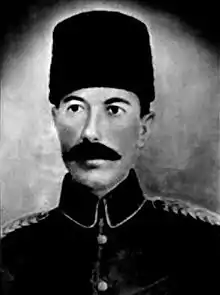Halid Beg Cibran
Miralay Halid Beg Cibran (Kurdish: Xalîd Beg Cibranî)[1] (born 1882 in Varto, Muş; 14 April 1925 in Bitlis) was a Kurdish soldier in the Ottoman and Turkish army and chairman of the Azadî organization.
Halid Beg Cibran | |
|---|---|
 | |
| Born | 1882 |
| Died | 14 April 1925 |
| Cause of death | Executed |
| Nationality | Kurdish |
| Citizenship | Turkish |
| Alma mater | Ottoman Military College |
| Organization | Azadî |
Early life and education
He was born in Varto in 1882. His father Mahmut Bey was the leader of the Sunni Cibran tribe. The Cibran was an influential Kurdish tribe and used to work closely with the Ottoman government.[2] In exchange the Cibrans were allowed to set up regiments for the Hamidiye.[2] Halit Bey has attended the Aşiret (tribal) school in Istanbul.[2] Afterwards he was the followed up on his studies at the Ottoman Military College. He joined the Ottoman Army and as World War I broke out, he commanded a Hamidiye regiment, which consisted of three lightly armed cavalry constituted by members of the Cibran tribe, and fought against the Russian army. Following he was elevated to the rank of colonel (Miralay). During the Turkish War of Independence, he sided with Mustafa Kemal (later known as Atatürk) and took a stand against the government in İstanbul.[2]
Kurdish rebellions
But after the Koçgiri uprising, he began to oppose the Kemalists.[3] He led the uprising at Beytüşşebap in 1924, before the Sheikh Said Rebellion was launched in 1925.[1] In 1892, he became the leader of the second Hamidiye regiment and was in charge of leading the
attack on Zeynel Talu Hermekli in 1894,[4] the son of the Alevi Ibrahim Talu, who was killed by troops of the second Hamidiye regiment under the command of Halid Beg Cibran in 1906. The Alevi tribes wouldn't forget such treatment by the Sunni, and wouldn't join the Sheikh Said Rebellion in 1925.[5] During World War I, he was deployed in the eastern front, and fought against then Armenians. It is reported that concerned about the possible betrayal of the Alevi Kurds, sent message to Kazim Karabekir, urging him to refuse their support in the battles.[6] After the war, he returned to the Dersim region, made first attempts to counter the Turkish nationalism and support the Kurdish cause, implying the Kurds to speak their language.[7] Following the signing of the Treaty of Sèvres in 1920, he garnered support for the Kurdish aims for self rule. He traveled to various towns in the region, such as Varto, Bingöl, Bulanik or Malazgirt and spoke to the Kurdish notables.[8] After the Koçgiri rebellion, he began to take up more and more positions against the Kemalists. According to Kurds reporting to the British intelligence, he established Azadi in Erzurum, the city where he formerly was a military commander, in 1921[9] of which he became its president.[10] The Azadi was a Kurdish society which later would become a leading force in the Sheikh Said Rebellion.[11]
He was captured in Erzurum on 20 December 1924[12] reportedly after having been accused of his involvement in the Beytüssebap revolt by Yusuf Zia Bey (another leader of the Beytüssebap revolt). Both were courtmartialed in Bitlis[13] and Halid Beg Cibran was hanged[14] on the 14 April 1925.[15]
References
- Üngör, Umut. "Young Turk social engineering : mass violence and the nation state in eastern Turkey, 1913- 1950" (PDF). University of Amsterdam. p. 231. Retrieved 9 April 2020.
- Behrendt, Günter (1993). Nationalismus in Kurdistan: Vorgeschichte, Entstehungsbedingungen und erste Manifestationen bis 1925 (in German). Hamburg: Deutsches Orient-Institut. p. 264. ISBN 3-89173-029-2.
- Özgürel, Avni (2015-12-14). "Radikal". web.archive.org. Retrieved 2020-07-09.
- Olson, Robert (1989). The Emergence of Kurdish Nationalism and the Sheikh Said Rebellion, 1880–1925. University of Texas Press. p. 26. ISBN 0292776195.
- Yadirgi, Veli (2017-08-03). The Political Economy of the Kurds of Turkey. Cambridge University Press. p. 100. ISBN 978-1-107-18123-6.
- Olson, Robert (1989), pp.26–27
- Olson, Robert (1989), p.27
- Olson, Robert (1989), p.28
- Olson, Robert (1989), p.42
- Olson, Robert (1989), p.96
- Olson, Robert (1989), p.41
- Olson, Robert (1989), p.92
- Chaliand, Gérard (1993). A People Without a Country: The Kurds and Kurdistan. Zed Books. pp. 52–53. ISBN 978-1-85649-194-5.
- Üngör, Umut. "Young Turk social engineering : mass violence and the nation state in eastern Turkey, 1913- 1950" (PDF). University of Amsterdam. p. 234–235. Retrieved 15 October 2020.
- Yilmaz, Özcan (2015). La formation de la nation kurde en Turquie (in French). Graduate Institute Publications. p. 86. ISBN 978-2-940503-17-9.
